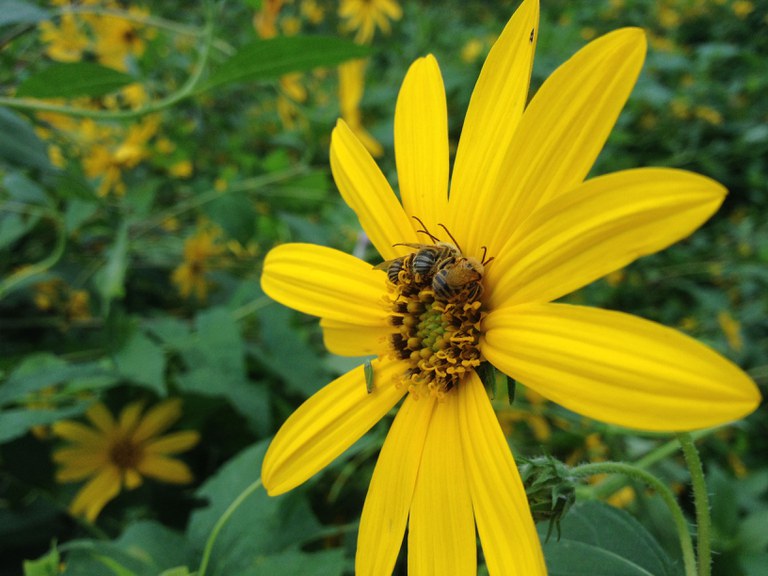Posted: February 27, 2019
With insect species declining and agriculturally-important pollinators at risk, it’s important to know what species are present in an area to help protect them. PhD student Shelby Kilpatrick is trying to find out what bees are present in Pennsylvania, and is creating a list that could help with future conservation efforts.

Three long-horned bees (Family Apidae, tribe Eucerini) on a sunflower (July 27, 2017, Awbury Agricultural Village, Philadelphia, PA). Photo by Shelby Kilpatrick.
"There's a lot out there, and sometimes we just don't realize how much we don't know until you take a closer look," says Kilpatrick, working with Dr. Margarita López-Uribe and Dr. Heather Hines in the Department of Entomology. Kilpatrick is also a fellow in Penn State's new Integrative Pollinator Ecology (IPE) Graduate Training Program.
To find out how many bee species are in Pennsylvania, Kilpatrick contacted researchers at universities, museums and natural history collections across the Northeast, acquiring records of bee specimens captured in Pennsylvania and compiling this into a single catalog. She has currently reviewed over 68,450 individual specimen records, which is about half of the total records she has, and she is still receiving more.
"It's surprising how many new bee species records there are for Pennsylvania," Kilpatrick says.
So far, Kilpatrick has confirmed 450 bee species in Pennsylvania, with 83 of these being species that were not recorded in the state's previous checklist of bee species, published in 2010. Kilpatrick has found new species records for 32 out of the 67 counties in Pennsylvania. And the numbers are still growing.
While it is a simple matter to see where a species was collected, it is much more difficult to see if that species is still there. The only way to verify a species' presence is to see where it was collected from, revisit those locations and do targeted sampling there to see if it can be found again.
With 450 bee species and counting, it is impossible to do this for every species. But by publishing an updated checklist of all bee species collected in Pennsylvania, Kilpatrick's work will serve as an important resource to those who want to verify the presence of rare or agriculturally-important species and monitor their populations in the future. The checklist can also be used to track the effects of introduced bee species as well as diseases and parasites.
Kilpatrick presented her work internationally in Vancouver, Canada, during November 2018 at the Annual meeting of the Entomological Collections Network, as well as the Joint Annual Meeting of the Entomological Society of America, the Entomological Society of Canada, and the Entomological Society of British Columbia. She also presented her research locally in State College, PA at the November 2018 meeting of the Pennsylvania State Beekeepers Association.
The data will also be made available as a public website for anyone interested in seeing what kinds of bees are found in their backyards and hometowns. By knowing what species are found in certain areas, this will also help pollinator gardens choose which plants to grow to support local bees.
Kilpatrick is fascinated by insect biodiversity.
"With fieldwork, you never know exactly what you're going to find," says Kilpatrick. "I think that's why I really like fieldwork so much and research in general, because you always get to discover new things."
References:
Kilpatrick, S.K., J. Gibbs, M.M. Mikulas, S. Spichiger, N. Ostiguy, D. Biddinger, and M.M. López-Uribe. 2018. Checklist of the Bees of Pennsylvania. http://lopezuribelab.com/checklist-bees-pennsylvania/

